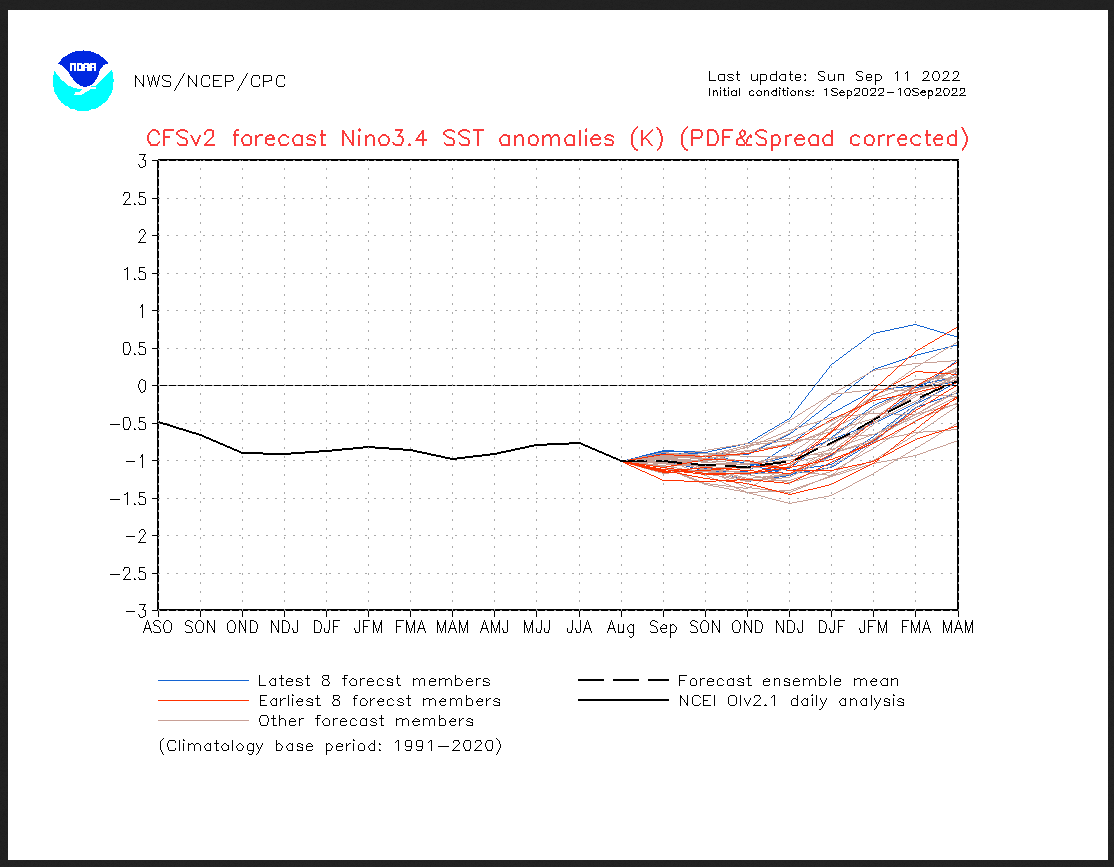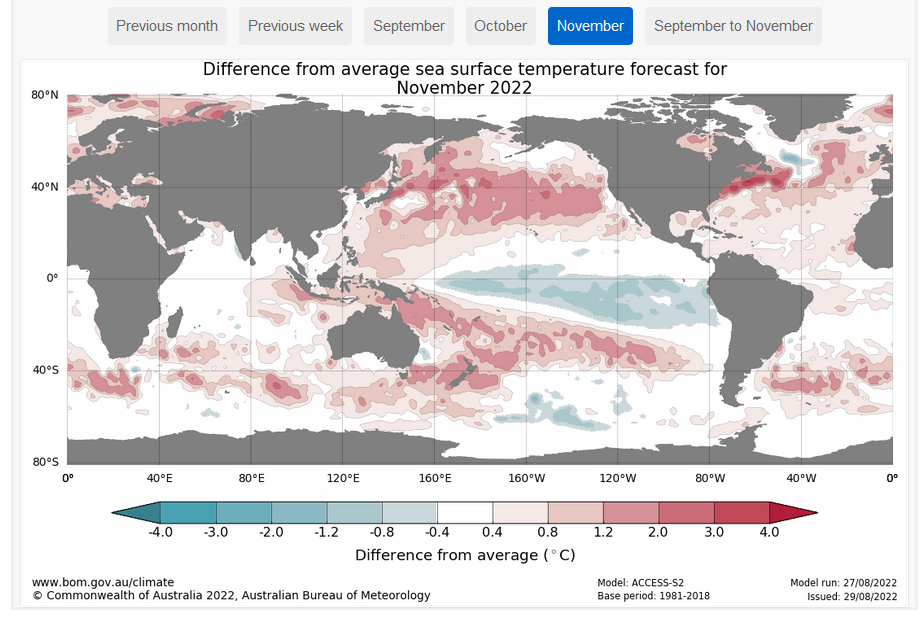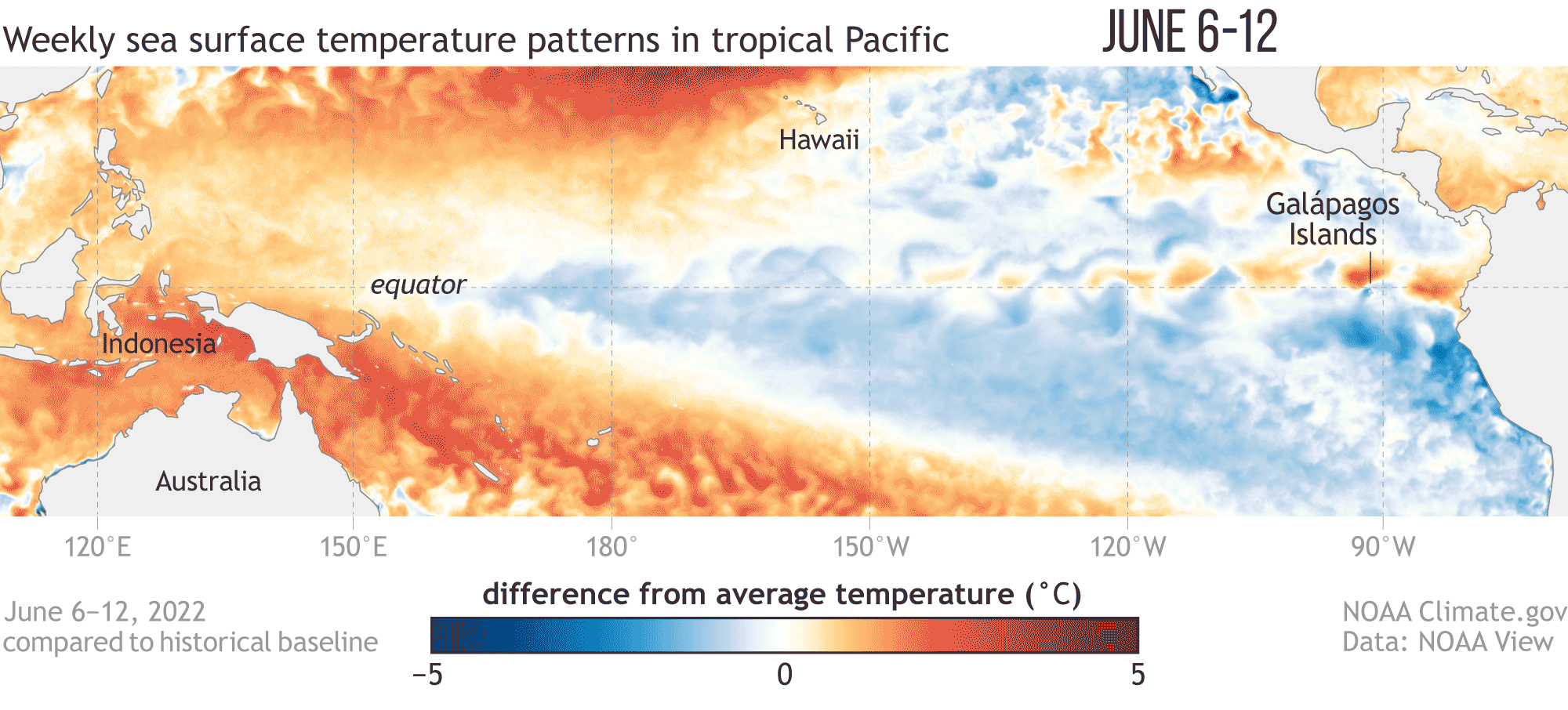On the second Thursday of every month, NOAA issues its analysis of the status of ENSO. This includes determining the Alert System Status. Although the current status remains the same i.e. La Nina Advisory, the forecast has been adjusted slightly from last month. The IRI analysis suggests it could be slightly later than it appeared last month. Also, the probability that it will extend into the winter is much higher. So what I anticipated as being a three-peat looks to be a reality. But in theory, things could change.
Nevertheless, that is what both NOAA and I think will happen. But it could happen a bit earlier or a bit later.
I provided a small sample of model runs by a number of different meteorological agencies that is presented by the Australian Bureau of Meteorology (BOM) and they suggest that maybe we will be in ENSO Neutral in January or February rather than March as NOAA seems to be thinking. NOAA is placing more weight on the statistical rather than dynamic models but statistics requires data and there have not been a lot of similar situations but what data there is suggests March is more likely than January or February. But perhaps this La Nina will continue beyond March. Maybe it will continue for a fourth year.

| Announcement: We now publish a daily weather report that addresses both short-term and intermediate-term weather issues and you can find it at econcurrents.com. To return to this article just hit the return arrow at the upper left corner on your screen |
ENSO IMPACTS
The impact of the NOAA forecast for the slow or non-existent transition from La Nina to ENSO Neutral will show up next Thursday when NOAA issues its Seasonal Outlook. The NOAA ENSO Status Update provides an advance indication of how the Outlook might change. There is a lag between the ENSO state and the impact on U.S. weather. Thus the exact strength of the La Nina may not be very important in terms of the actual impact on Summer weather including the North American Monsoon (NAM). We may see some changes, in particular Fall and Winter of 2022/20223 and Spring of 2023, farther out in the NOAA Outlook that will be issued next Thursday.
I have also reported on the Indian Ocean Dipole (IOD) because of the potential impact on world food production.
CLIMATE PREDICTION CENTER ENSO DISCUSSION
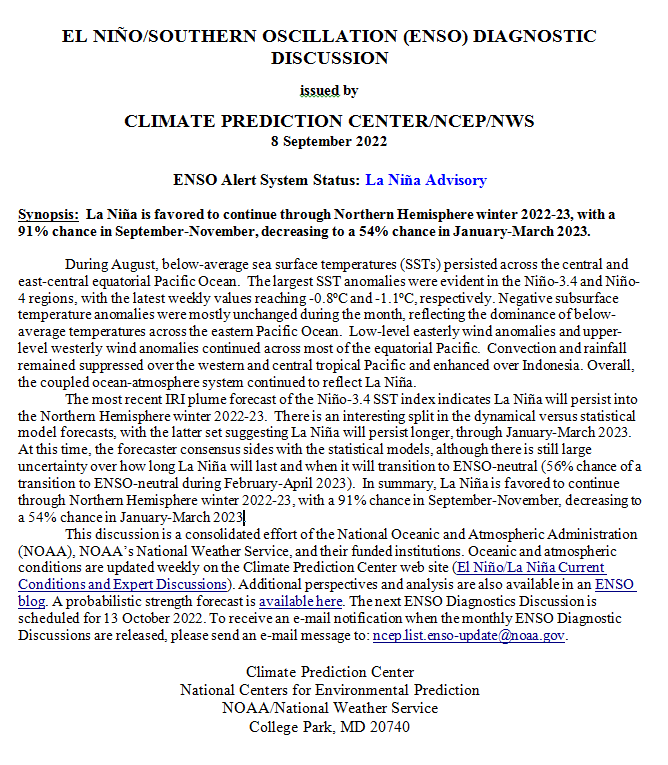
| The second paragraph is what is important: “The most recent IRI plume forecast of the Niño-3.4 SST index indicates La Niña will persist into the Northern Hemisphere winter 2022-23. There is an interesting split in the dynamical versus statistical model forecasts, with the latter set suggesting La Niña will persist longer, through January-March 2023. At this time, the forecaster consensus sides with the statistical models, although there is still large uncertainty over how long La Niña will last and when it will transition to ENSO-neutral (56% chance of a transition to ENSO-neutral during February-April 2023). In summary, La Niña is favored to continue through Northern Hemisphere winter 2022-23, with a 91% chance in September-November, decreasing to a 54% chance in January-March 2023. |
| We now provide a lot of additional detail. The detail is for those who will find it interesting. If your main interest was in learning what the current Status of ENSO was and how long will the current state last, you may not need to read the remainder of this article as that information has already been presented above. If you are interested in how reliable the conclusion is and why one might accept the conclusion or be skeptical about the conclusion, continue to read. |
IRI CPC ENSO STATE Probability Distribution (IRI stands for the International Research Institute for Climate and Society)
Here are the new forecast probabilities. This information is released twice a month and the first release is based on a survey of Meteorologists, the second is based on model results. The probabilities are for three-month periods e.g. JAS stands for July/August/September.
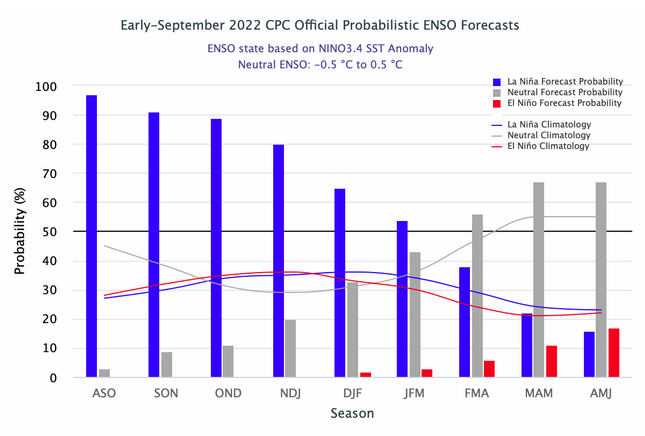
| Notice for JFM 2023 the probability of La Nina and ENSO Neutral is no longer equal. But for FMA the probability for ENSO Neutral Exceeds that for La Nina. So maybe March is when the ocean conditions will be consistent with ENSO Neutral but the impact on our weather may lag a month or so. So we really seem to be looking a La Nina into Spring. This is a very slight change from the analysis made last month. |
Here is the forecast from Last Month. It is not very different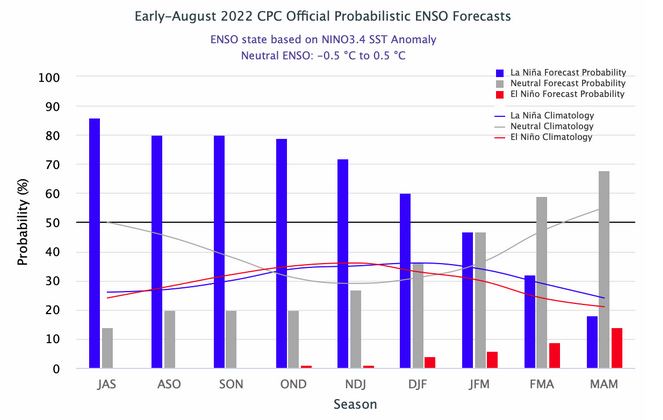
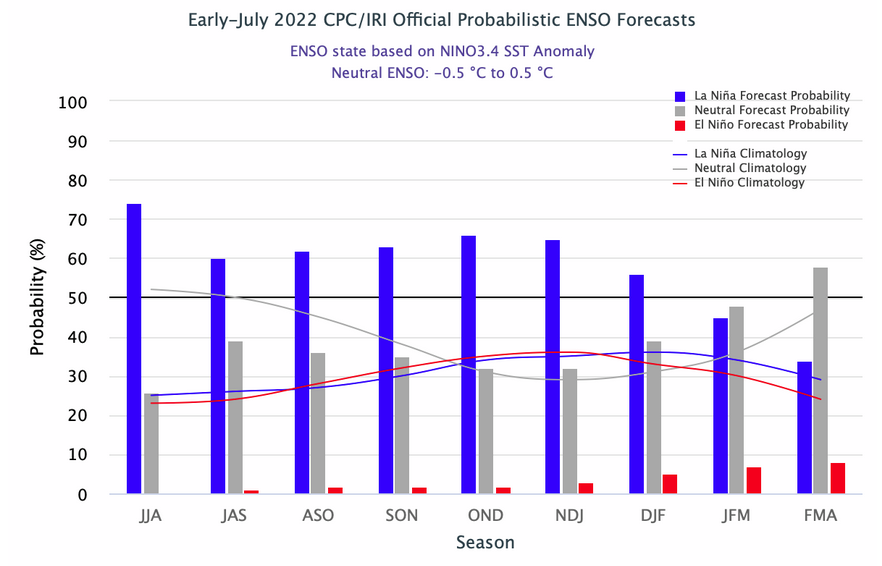
Analysis of the current and prior first and second Forecasts in each month.
IRI actually makes two forecasts a month. The first which is based on a survey of meteorologists is the one that NOAA relies on when they prepare their seasonal outlook. The second is a summary of the forecasts made by a set of computer models.
Here are six sets of those forecasts. For the first set, the initial forecast is also shown above. There is a pattern here. The chances of a Three-peat have increased each month and the survey of meteorologists has routinely been more convinced than the computer models that La Nina will persist. A possible reason for that is that some of the computer models are statistical models and from a statistical perspective a Three-peat is highly unusual. I am showing six of them because they do not take up much space and it provides the reader with the way that the assessment has been jumping around a bit.








I will let the reader sort out what can be learned from the above
Recent ENSO History.
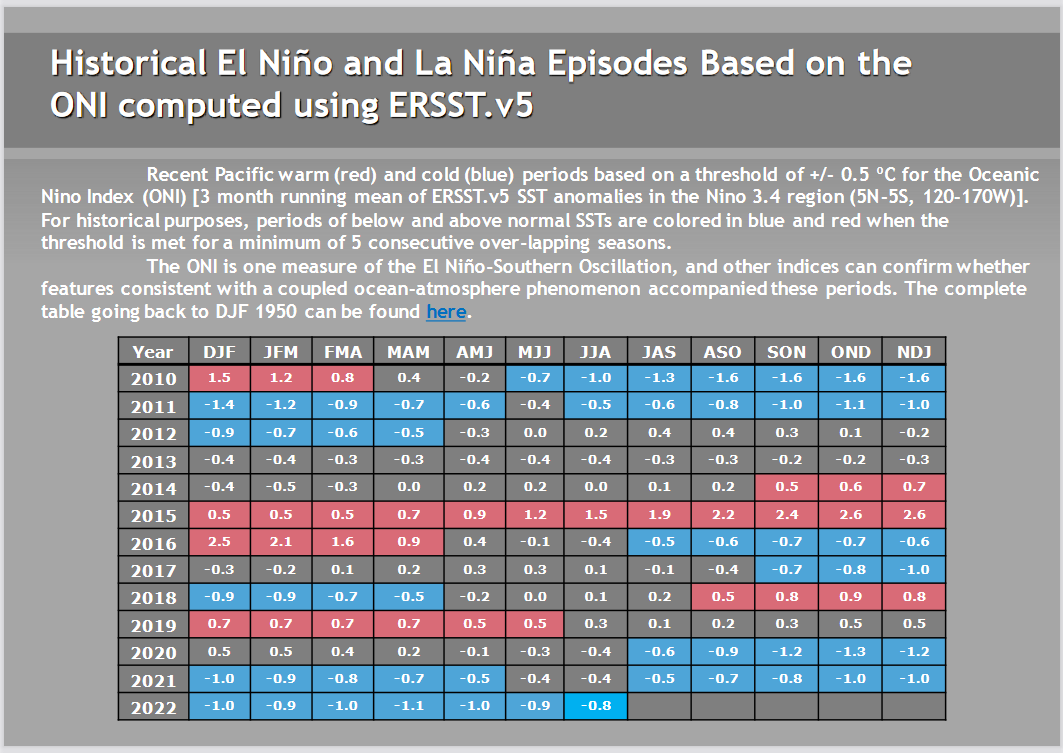
| The three-month average of Nino3.4 readings becomes the Oceanic Niño Index or ONI So that is an official number subject to change when they update the climatology. What you can see here clearly is the duration of the three phases of ENSO. So we have been in La Nina since JAS 2020. La Nina rarely goes beyond two years. This one looks like it will. Hence “Three-peat”. You can access the full history Here https://origin.cpc.ncep.noaa.gov/products/analysis_monitoring/ensostuff/ONI_v5.php Later I show an interesting graphic that appears in the Blog post written by Emily Becker which addresses the question of how often a re-peat becomes a Three-peat. There are reasons why it is unlikely but with Global Warming, history may not be as good a guide as usual. ENSO is something like a cycle. Could the length of that cycle be changing? So that is a question that some are thinking about. At first glance, it would seem that La Nina would be rarer rather than more frequent since it is associated with cool water in the Eastern Pacific. But the obvious does not always turn out to be correct. We have now recorded another 3-month ONI that was in La Nina territory. I just noticed there was a long string of La Nina ONI’s in 2010 through 2012 but there was one neutral reading that broke the string. But we have the same string in 2021 so I guess they do not count. |
What Does the NOAA Proprietary ENSO Model Forecast?
| The index is calculated as the monthly difference between the western (10°S-10°N, 50°-70°E) (WTIO) and eastern Indian Ocean (10°S-0°, 90°-108°E) (SETIO) sea surface temperature departures from average. |
| The above may auto-update. If that does not work you can click HERE. https://www.cpc.ncep.noaa.gov/products/people/wwang/cfsv2fcst/images3/nino34SeaadjPDFSPRDC.gif NOAA relies more on the IRI Forecast. But perhaps this model is now showing that we may become ENSO Neutral (Nino 3.4 Index great than -0.5C) for next Spring or even the second half of Winter. It is showing it happening later than it had been showing it. If you look carefully for the mean of the various computer runs it intersects -0.5C in JFM 2023. So that is basically saying that La Nina will be with us for the entire winter. |
Looking at Actual Current Conditions.
NOAA reports some derived data that describes the current situation and a forecast. But what if we want to form our own opinion? After all, meteorologists are looking at the actual current situation and making predictions.
This shows the current actual situation.
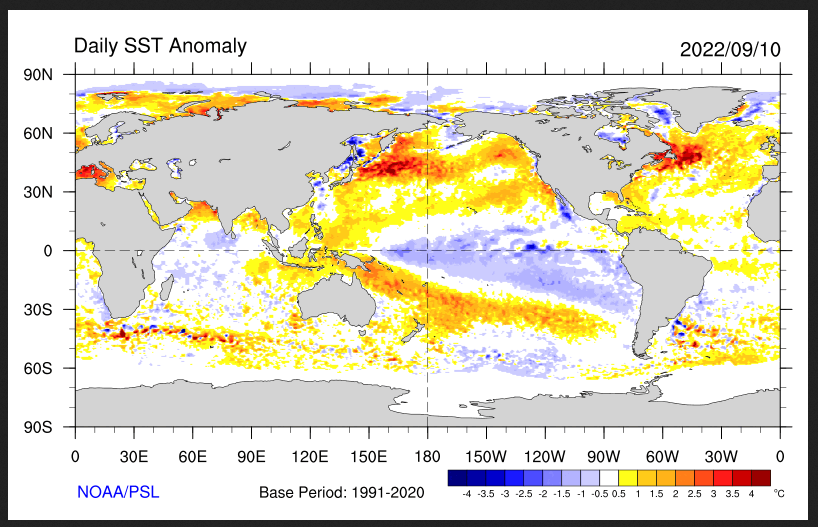
![]()
| Notice the cool water is almost all south of the Equator but the pattern extends to the west more than usual. To update this graphic click here https://psl.noaa.gov/map/images/sst/sst.daily.anom.gif |
| This is the same information presented by the Australian BOM only it is a forecast for November. The is not sign of La Nina being gone by November. I could also present one from NOAA. Everyone has access to the same data but they all have their own ways of presenting the data. NOAA updates their map every day and BOM weekly or every two weeks so there can be slight differences. |
Where is ENSO Measured?
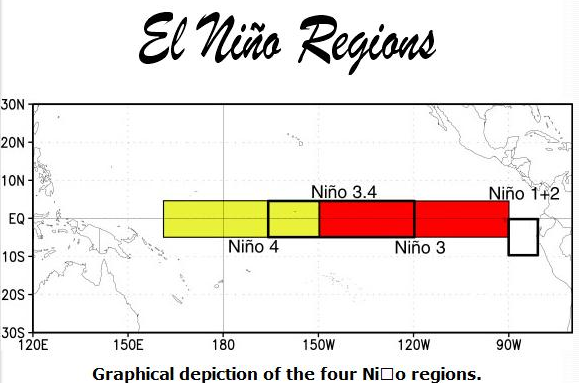
You can mentally superimpose the Nino 3.4 area shown encompassing part of the yellow and part of the red areas in the above map and you can see that it is cool in the Nino 3.4 area especially South of the Equator. That is an oddity of this La Nina that is both westerly displaced and focused mostly south of the Equator. There is not much discussion of that and how that might impact our weather. It certainly explains why the NINO 3.4 Index is still in La Nina territory but warmer than last month.
One can also see that we remain in PDO-(Neg).
How About the Future?
ENSO is measured at the surface of the ocean because it is the surface that interacts with the atmosphere. But the surface changes over time so we pay a lot of attention to the subsurface. Here we are just looking at the Equator but from the surface down to 450 meters. And we are looking at the temperature anomalies (deviations from normal this time of year at the given depth and longitude). The Nino 3.4 Index is measured at the surface but the subsurface may become the future surface. There is anomalously cool water almost everywhere on the surface.
Here is what it looks like now. Does it look like it will soon be other than cool? It is complicated because we are looking at anomalies not absolute temperatures and we are only looking at a cross-section at the Equator when the Nino 3.4 Area extends five degrees north and south of the Equator but there is only so much information that can be presented in one graphic. Sea Surface Temperature Anomalies are only one component of ENSO but probably the most important component and La Nina is relative to SSTA is defined as -0.5C or colder.
Off to the west, the warm Indo-Pacific Warm Pool has receded from prior months but it is quite intense with maximum anomalies of 3 degrees Celsius. And we must remember that these anomalies are calculated based on the seasonal norms for water at that depth. So three degrees warmer than usual does not mean it is warmer than the water at the surface. So it will not automatically rise.
Mapping the details.
The data is a five-day average centered on the date shown.

Putting it in motion
| All I see is a lot of cold water (what is shown is anomalies compared to climatology for location and time of year. I am not showing the prior versions this time. But the above is clearly la Nina and the warm IndoPacific Warm Pool shows no indication of moving east to replace the cool water that defines a La Nina. The cool anomaly is mainly south of the Equator and it extends far to the west making it what the Japanese call a Modoki. |
Another way to look at the same information
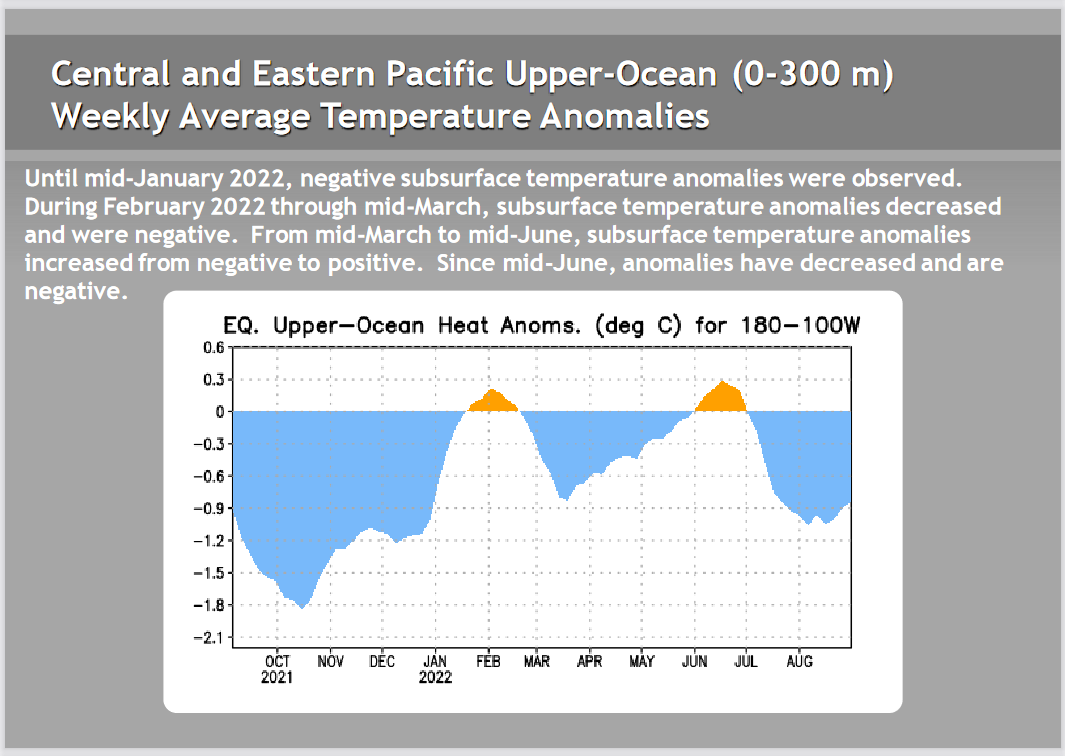
| There is no indication that the Eastern Pacific is warming. In the above, the anomalies from the surface down to 300 meters are added together. It is now a tad warmer than two weeks ago. |
Are the changes significant? We need to look at additional information.
Another way of looking at the situation is the impact of the Oceanic Kelvin Waves.
What is below explains a lot.
We described Oceanic Kelvin Waves in the article some months ago but let’s just say they are near-surface waves confined to the Equator which can move warm water east and help end a La Nina. The downwelling phase of such a wave is shown in red and the upwelling phase is shown in blue. The recent Kelvin Wave made it look more likely that we would transfer to ENSO Neutral. But it turned out to be a fairly weak Kelvin Wave not followed by another one although we might see one forming in this graphic.
| The onset and evolution of the recent Kelvin Wave explain most of the changes in the probabilities from one release to the next so I think the Meteorologists may not have been paying as careful attention to this as they might have. You have to look at the Hovmoller carefully since it is showing things over time. The dates are shown. And we are mostly interested in what is currently taking place between 170W and 120W and what we can expect to happen as the waves progress to the east. There are no signs yet of another Kelvin Wave. |
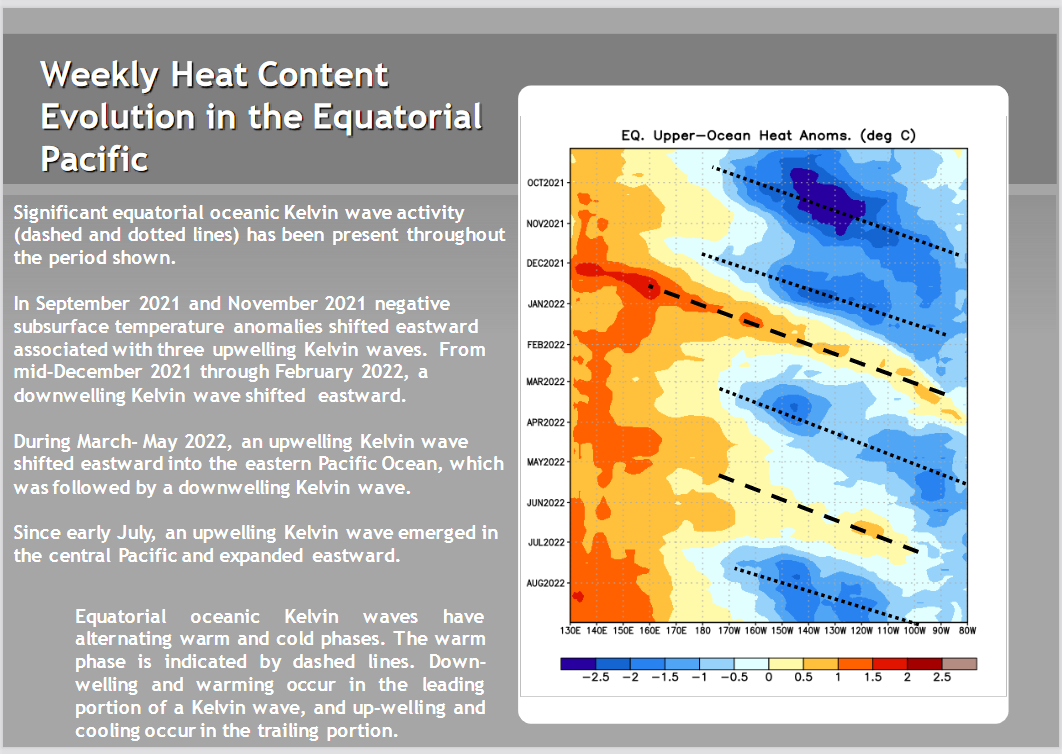
Looking at the Wind Anomalies. This is another way to try to understand what is happening and this is another Hovmoller chart. I am pretty sure they used to create these charts with a plotter and every day the roll would unwind and there was one more day’s worth of data added. The format remains and it still works pretty well.
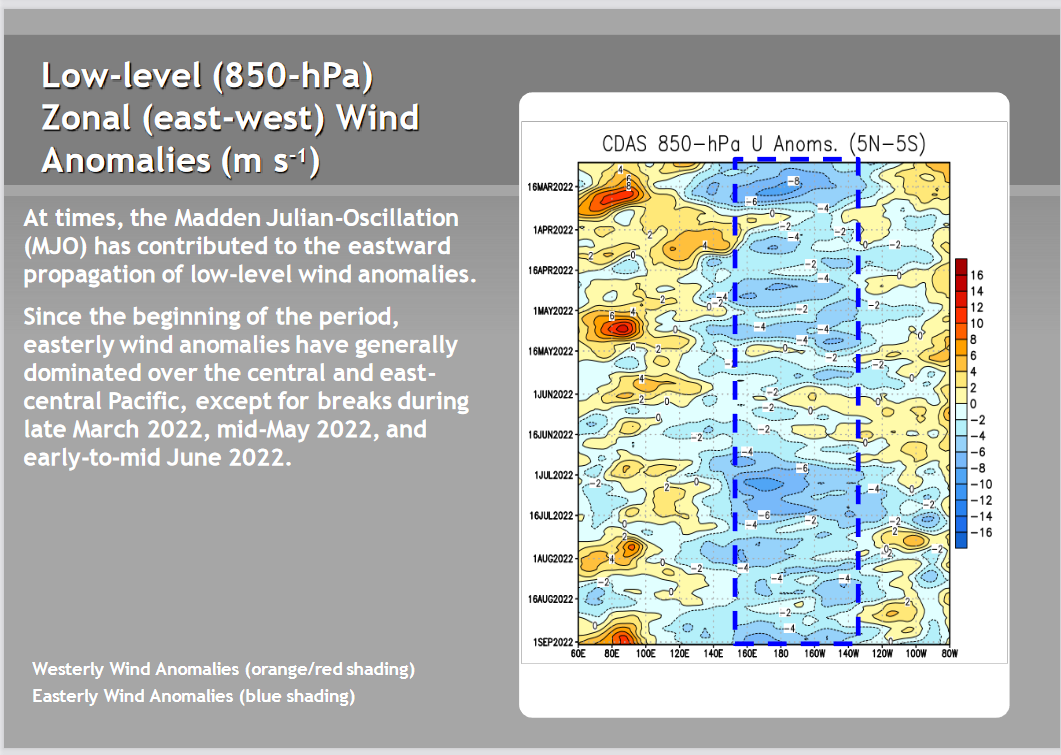
My conclusion is we do not know yet when this La Nina will be over if ever. I take that back, La Nina can not persist forever but there could be a Triple Dip which would cause a lot of problems.
| This is a Hovmoller graphic. It is sort of what comes off of a plotter so the most recent information is at the bottom and the earlier information is at the top. Easterlies tend to be associated with La NIna since the Warm water in the IndoPacific Warm Pool can not easily move east. There is no sign of the Easterlies weakening. |
From the NOAA ENSO Blog
A good resource is the posts by Emily Becker. I have extracted some of the graphics but you can click on the below to read her full post or click here

There has been an interesting graphic for some months now in the NOAA ENSO BLOG which was written by Emily Becker. All La Ninas since 1950 which had a double-dip are shown. The black line is our current La Nina.
She has a new graphic this month.
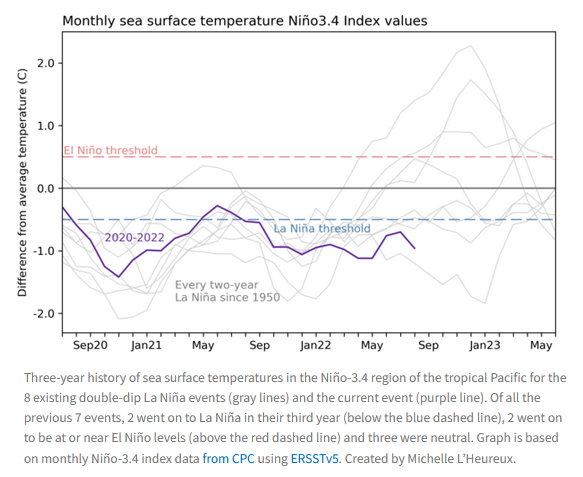
And Last Month
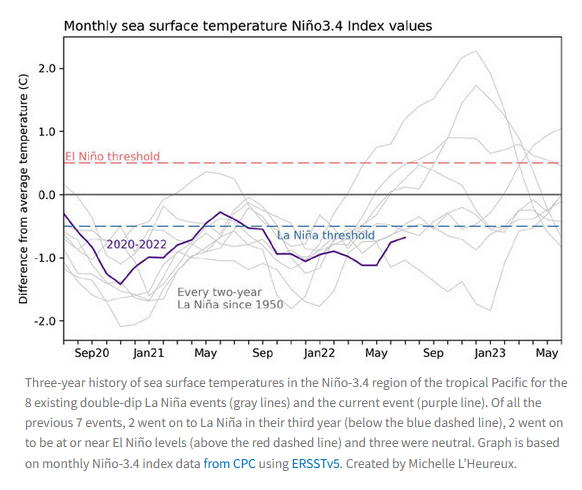
And the prior month I am showing it because the graphic is of better quality but the second one above includes the latest month for the current event.
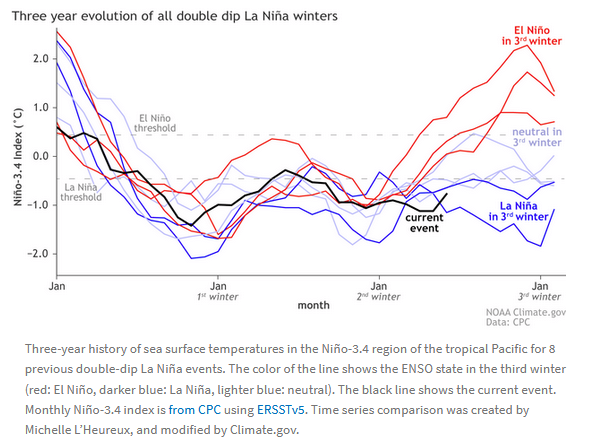
–
| The black line is the current La Nina. It no longer looks like it is moving towards the ENSO Neutral Range. |
What do Other Meteorological Agencies Say
I do not have the time or resources to check what all of the various meteorological agencies have to say on this. NOAA publishes (or is it IRI) what they call a plume of forecasts from many models not just those operated by the U.S. Last month those models seemed to show that ENSO Neutral with a strong bias towards La Nina was most likely. By a strong bias, I mean the forecast was for Nino 3.4 to be in the lower end of the ENSO neutral range. But the updated version of this “plume” will be published with the second IRI report so I do not have it now. But I do have a report from the Australian Meteorological agency (BOM which shows a subset of models.
Australian BOM
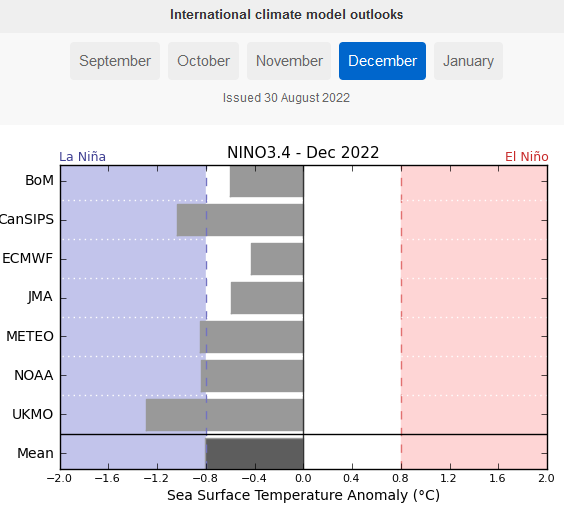
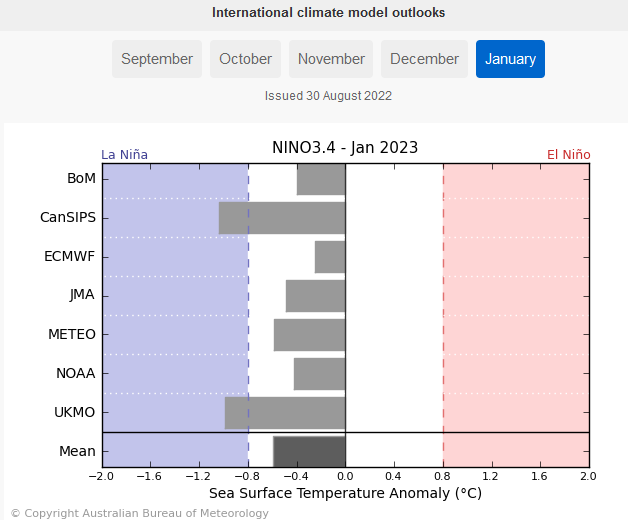
| This time I have not shown prior months as the article gets longer and longer. This is a small set of models but a good one. This is a forecast for December 2022 and January 2023 and there is a lot of variability. For December 2022, they all show Nino 3.4 to be negative but not for January of 2023. Notice that the Australian threshold is -0.8 as that is the threshold that is used by the BOM to determine when a negative Nino 3.4 Index is cool enough to be considered in La Nina territory. But the scale is shown so you can see which models are colder than -0.5C. |
JAMSTEC (I have not received their forecast yet)
Australia BOM forecast
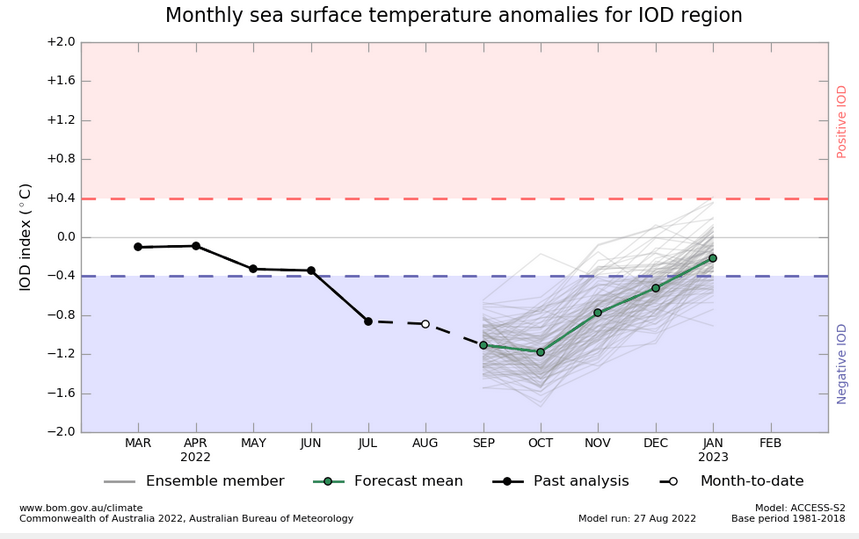
This shows the Walker Cycle for IOD Negative which is predicted.
–
| It is important to understand the Walker Circulation pattern of where moisture is rising (from warm water) and later falls as precipitation. |
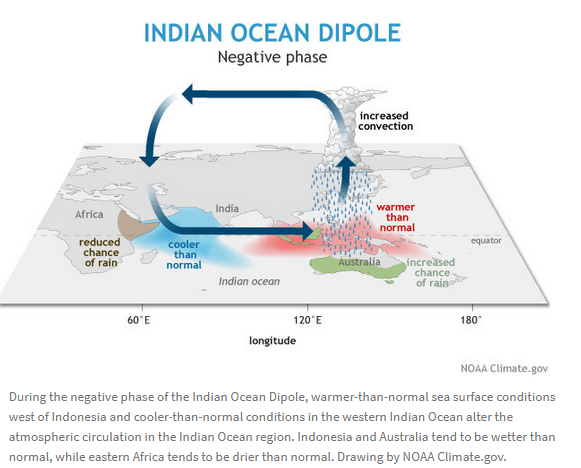
| Normally you would expect a Negative IOD to result in a poor monsoon for India not flooding. So something strange is going on. |

Here is IOD Neutral
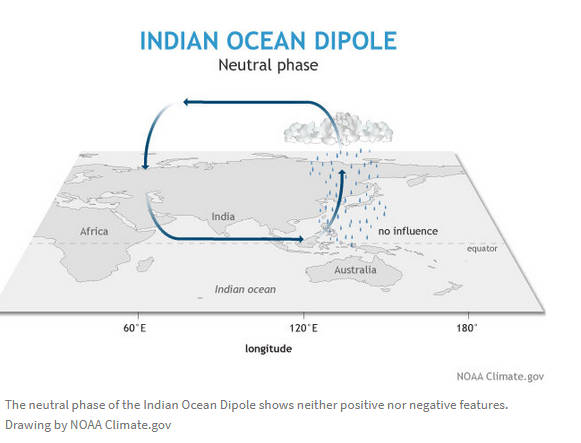
Here is IOD Positive
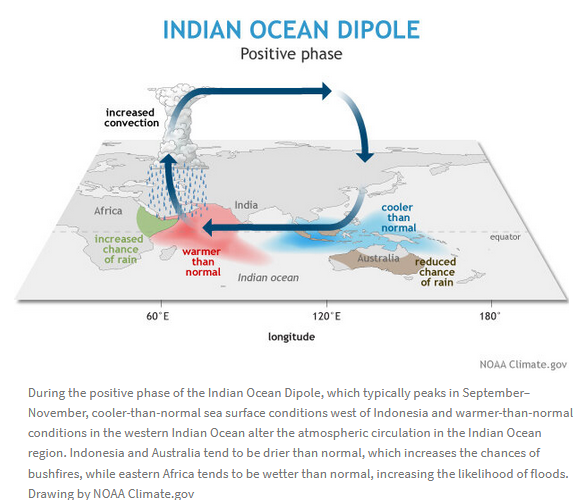
And here is how the Index is calculated (The SWIO is another Index not used to calculate the IOD the index of which is sometimes called the DMI)
| The index is calculated as the monthly difference between the western (10°S-10°N, 50°-70°E) (WTIO) and eastern Indian Ocean (10°S-0°, 90°-108°E) (SETIO) sea surface temperature departures from average. |
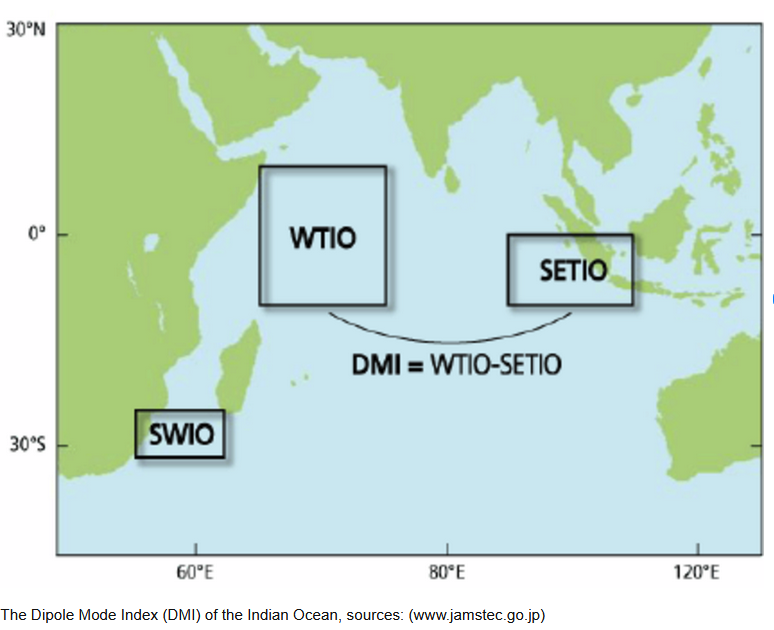
–
